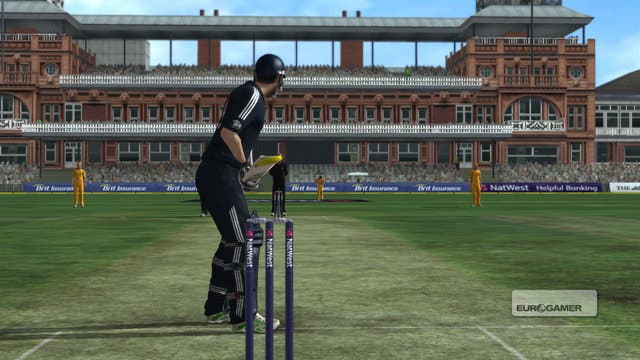International Cricket 2010
A certified cricket coach writes.
Sports sims give me big problems. A very large question looms into view: Why?
Role-playing games exist because a lot of people want to transport themselves to a post-apocalyptic landscape, shoot malevolent zombies, go on insane quests for medieval bling which will grant them special powers, or just lose themselves in the land of Whojamaflipponia. Strategy games are there for all those people who never got to have their hands on real power (although it is questionable whether anyone playing Sim City or Tropico would actually want to be Boris Johnson) and we do not need to be rocket scientists to understand why Tomb Raider was so particularly successful with 16-year-old boys who had recently discovered the auto-erotic experience.
In short, most games give you a place to go and an experience that you can't get any other way without great difficulty and/or expense. But sports games are a simulation of something we can actually do for real, for quite a lot less than the cost of most computer games, and get more enjoyment out of it. Of course, not everybody is going to face Brett Lee in a torrid 20/20 floodlit game at Lord's, but trying to deal with Mr Lee's yorkers and inswingers by thumb and forefinger dexterity, on the Xbox screen, comes a long way short of actually playing the game (as I do) at the elevated level of the Dulwich Cricket Club 6th XI.
This latest incarnation of the cricket sim does nothing to dispel my belief that Cricket remains a truly wonderful game to play and watch. However, International Cricket 2010 does not even get you half way there and, in fact, left me (a Level 2 cricket coach) with a worrying feeling that anyone who has never "wielded the willow" or "turned their arm over" on the green sward would be unlikely to try after dabbling with this pale imitation of the real thing.
For the beginner, a lengthy and frustrating time with the game's tutorial awaits you. Wading straight into a game will leave you confronted with a whole lot of unlikely bright green circles on the pitch and some bewildering HUDs which change considerably whether you are batting or bowling and then change again if you are bowling slow or fast, seam or swing, leg spin or off spin.

That said, the tutorial is nothing if not comprehensive: for the batsman, all the conventional shots are available for you to try. You are urged to check for gaps in the field and keep them in mind as the bowler approaches. The aforementioned green circle appears as the bowler begins his run, just on or past a good length (if you are practising the front foot drive) and short of a length if you are essaying the pull shot or the back foot drive.
The green circle tells you where the ball will pitch: if only these green circles were available when Dulwich 6th XI bat. Imagine batting against a bowler who draws a green circle on the pitch so you know where he intends to bowl every ball before he's bowled it!
The bowling is all about timing your instant of delivery so you can avoid bowling no balls and bowl at the stumps. A delicately poised pointer operated by the joystick tells the player if he is going to bowl a good length ball on the stumps and a meter tells him (or her) the optimum moment to let go of the ball: too late, and it's a no ball, too early and it's a short wide ball! Swinging the ball necessitates you controlling the seam's direction, never easy in Cricket, but virtually impossible in IC 2010. Slow bowling is sub-divided into off-spin and its attendant variations (including the "doosra") and leg-spin.
Fielding, the activity you spend most time doing in a real game of Cricket, is dealt with in a more truncated fashion: you are told that when a catch goes up, a circle will appear on the screen which will change from red to amber to green: click when the circle turns green and you hold the catch. Sounds easy enough till you realise that the amount of time the circle is green is shorter than a size S T-shirt from Primark. This runs entirely contrary to the cricket coach's primary mantra: "Watch the Ball". Do that, and you will not hold a single catch in IC 2010.







